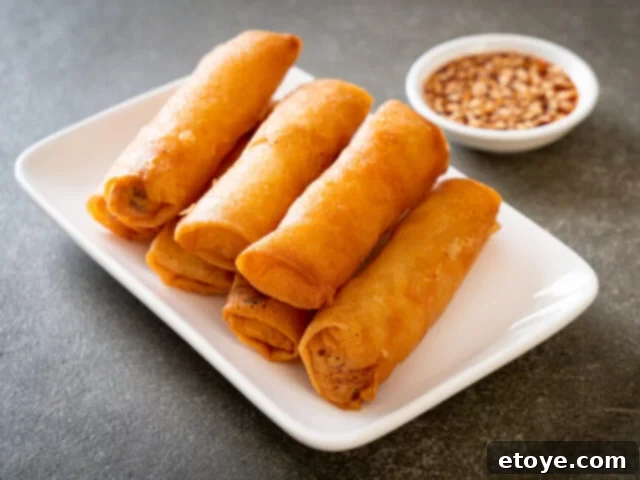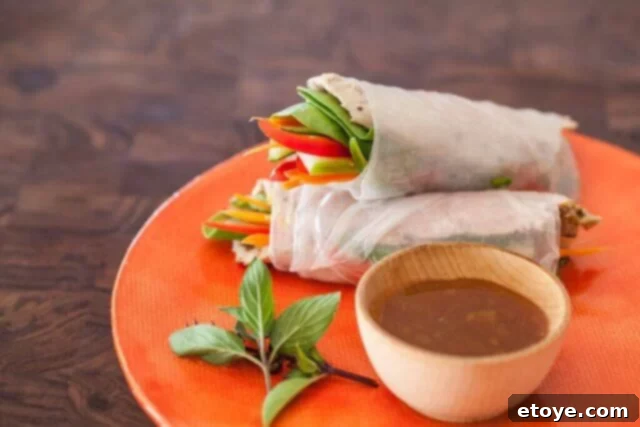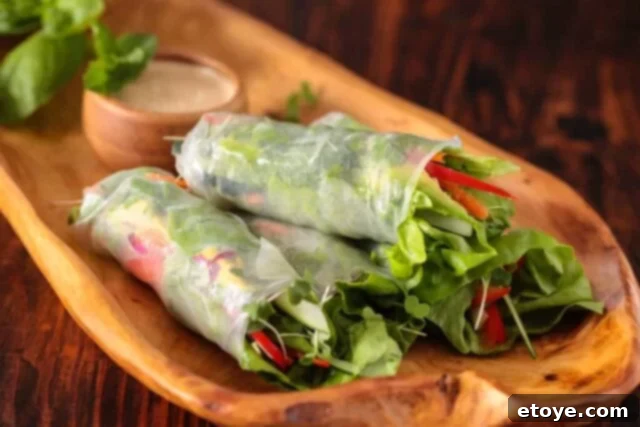We’ve all experienced that delightful moment: a successful dinner featuring an abundance of delicious spring rolls. But what comes next? You’re left with a fridge full of tantalizing leftovers, pondering their longevity and the best ways to keep them fresh. Whether these versatile delights are the star of your meal or a delightful accompaniment to a light lunch, understanding how to properly store cooked spring rolls is key to extending their deliciousness. This comprehensive guide will answer all your pressing questions, ensuring you can savor every last bite long after the cooking is done.
Understanding Spring Roll Shelf Life: The Essential Guide
So, you’re eager to know: exactly how long do spring rolls last once they’re cooked? The concise answer is typically 2 to 3 days when stored correctly in an airtight container within your refrigerator. However, this isn’t a definitive, one-size-fits-all rule. The actual shelf life of your fresh or fried spring rolls can be influenced by several critical factors. Let’s delve into these important details to maximize your spring roll enjoyment and ensure food safety.

Key Factors Influencing Spring Roll Freshness and Shelf Life
The longevity of your spring rolls isn’t just about the calendar; it’s a dynamic interplay of various elements. Understanding these factors is crucial for proper storage and ensuring a safe, enjoyable culinary experience:
- Origin Matters: Homemade vs. Store-Bought: The source of your spring rolls significantly impacts their shelf life. Homemade spring rolls, crafted with the freshest ingredients, often boast superior taste and texture. However, they typically lack the preservatives found in commercially prepared rolls. Store-bought varieties, while convenient, often contain additives designed to extend their freshness, potentially adding an extra day or two to their refrigerator life compared to their homemade counterparts.
- The Filling: Ingredients at the Core: What’s inside your spring roll plays a pivotal role. Ingredients like delicate green leaf lettuce, crisp bean sprouts, fresh herbs, or thinly sliced green onions are highly perishable. These components are prone to wilting, losing their vibrant texture, and contributing to quicker spoilage. Similarly, seafood fillings like shrimp or crab, and even some minced meats, have shorter shelf lives than purely vegetable-based fillings. The overall shelf stability of a spring roll is often dictated by its most perishable ingredient, so choose your fillings wisely with storage in mind.
- Storage Practices: The Gold Standard for Preservation: How you store your spring rolls is paramount. Improper storage, such as leaving them uncovered or at room temperature for extended periods, drastically reduces their shelf life. We’ll explore the best practices for optimal storage in detail shortly, covering refrigeration and freezing techniques that can make a substantial difference.
- Exposure to Room Temperature: The “Danger Zone”: Food safety guidelines warn against leaving perishable foods, including cooked spring rolls, at room temperature for too long. Bacteria multiply rapidly between 40°F (4°C) and 140°F (60°C) – often referred to as the “danger zone.” Ideally, cooked spring rolls should not be left out for more than two hours. If the ambient temperature is above 90°F (32°C), this time drops to just one hour. Prompt refrigeration is key to halting bacterial growth and preserving freshness.
- Sauces and Additives: Moisture and Acidity Considerations: While delectable, certain sauces and additives can inadvertently shorten your spring rolls’ lifespan. Homemade peanut sauce, citrus juices like lime, or even a generous amount of sesame oil can introduce moisture or acidity that accelerates spoilage. To maximize freshness, it’s generally best to keep your spring rolls as dry as possible and serve dipping sauces separately, applying them only just before consumption.
Recognizing the Red Flags: Signs of Spoiled Spring Rolls
Nobody wants an unpleasant surprise when biting into what they assume is a fresh spring roll. Being able to identify the signs of spoilage is crucial for your health and palate. Here’s what to look out for to ensure your spring rolls are still safe and delicious:
- Off-Putting Odor: Trust Your Nose: Your sense of smell is an excellent first line of defense. Fresh spring rolls should have a clean, inviting aroma, reflecting their ingredients. If you detect any sour, musty, moldy, or generally “off” scent – anything less than fresh and appetizing – it’s a clear indication that your rolls have likely gone bad. When in doubt, it’s always safer to discard them.
- Changes in Texture: Beyond the Crisp: While refrigeration can diminish the initial crispiness of fried spring rolls or slightly firm up fresh ones, they should never become slimy, mushy, or overly sticky. A slimy or excessively soft wrapper, particularly if accompanied by a noticeable odor, is a definitive sign of bacterial growth and spoilage. The internal ingredients should also maintain some structural integrity, not turn into an unrecognizable mush.
- Visible Mold Growth: An Unmistakable Warning: This is the most obvious and unequivocal sign of spoilage. If you observe any fuzzy green, black, white, or discolored patches on the wrapper or within the filling of your spring rolls, do not attempt to salvage them. Mold indicates significant bacterial and fungal growth, and consuming them poses a health risk. Discard them immediately and thoroughly clean any containers or surfaces they may have touched.
Remember the golden rule of food safety: “When in doubt, throw it out.” It’s never worth risking a stomach ache or more serious foodborne illness for leftover food that might be past its prime.
Mastering Spring Roll Preservation: Maximize Their Shelf Life

To extend the delectable life of your cooked spring rolls and ensure they remain enjoyable, follow these expert storage techniques:
- Optimal Refrigeration for Short-Term Freshness:
- Individual Wrapping: For best results, especially with fresh spring rolls, individually wrap each roll tightly with plastic wrap. This crucial step prevents exposure to air, which is the primary cause of drying out and oxidation, thus preserving moisture and preventing the wrappers from becoming hard or brittle.
- Airtight Containers: After wrapping, place the rolls in a shallow, airtight container. To further maintain moisture and prevent sogginess, you can line the bottom of the container with a slightly damp paper towel or a sheet of parchment paper. Arrange the spring rolls in a single layer to prevent them from sticking together or crushing delicate ingredients.
- Cooling Promptly: Always ensure spring rolls are cooled to room temperature before refrigerating. Placing hot food directly into the fridge can raise the internal temperature of the appliance, potentially affecting other foods. However, do not leave them out for more than two hours.
- Freezing for Extended Storage: Up to 2 Months: For those times you’ve made a large batch or want to enjoy spring rolls much later, freezing is an excellent option.
- Flash Freezing Cooked Rolls: Line a baking sheet with wax paper or parchment paper. Arrange your cooked spring rolls in a single layer on the sheet, ensuring they don’t touch each other. Place the entire sheet in the freezer for 2 to 3 hours, or until the rolls are completely solid. This “flash freezing” prevents them from sticking together.
- Transfer to Freezer Bags: Once frozen solid, transfer the spring rolls into heavy-duty freezer bags or airtight freezer-safe containers. Remove as much air as possible before sealing to prevent freezer burn, which can lead to dry, unappetizing spots. Label the bags with the date for future reference.
- Portion Control Tip: To make future meals more convenient, consider freezing spring rolls in single-serving portions within separate small bags. This allows you to thaw and cook only what you need, reducing waste and ensuring maximum freshness for each serving.
- Freezing Uncooked Spring Rolls: You can also freeze uncooked, assembled spring rolls using the same flash-freezing method. Once frozen, transfer them to freezer bags. This is perfect for meal prep, allowing you to fry or bake them fresh whenever a craving strikes.
- Thawing and Reheating Frozen Spring Rolls: One of the best aspects of frozen spring rolls is that they often don’t require thawing! Many varieties, especially fried ones, can be cooked directly from frozen. This method often yields the best texture and prevents them from becoming soggy.
Frequently Asked Questions About Spring Rolls
How Do I Reheat Cooked Spring Rolls for Optimal Flavor and Texture?
Reheating cooked spring rolls effectively means bringing back their desired crispiness without making them dry or soggy. The method you choose significantly impacts the outcome:
- Oven Method (Recommended for Crispy Results): Preheat your oven to 350°F (175°C). Place the spring rolls in a single layer on a baking sheet lined with parchment paper. Bake for approximately 10-15 minutes, flipping them halfway through, or until they are thoroughly heated and the wrapper is crispy to your liking.
- Air Fryer Method (Highly Recommended for Speed and Crispness): An air fryer is arguably the best tool for reheating spring rolls, delivering exceptionally quick and crispy results. Preheat your air fryer to 375°F (190°C). Place the spring rolls in a single layer in the air fryer basket, ensuring they are not overcrowded. Cook for 5-8 minutes, shaking the basket halfway through, until they are hot and perfectly crisp.
- Avoid Microwaving: While convenient, microwaving is generally not recommended for reheating spring rolls. The microwave’s rapid heating process tends to steam the rolls, resulting in a soft, soggy, and unappetizing wrapper rather than the desired crisp texture.
Can I Prepare Cooked Spring Rolls Ahead of Time for a Party or Gathering?
Absolutely! Preparing spring rolls ahead of time is an excellent strategy for entertaining. Here’s how to do it:
- Assemble in Advance: You can assemble the spring rolls according to your recipe well in advance of your event.
- Proper Storage Before Cooking: Store the assembled (but uncooked) rolls in the refrigerator until just before you’re ready to fry or bake them. It’s crucial to cover them with plastic wrap or a slightly damp towel to prevent them from drying out, which can cause the wrappers to crack during cooking.
- Cook Just Before Serving: For the best texture and taste, fry or bake your spring rolls right before serving. This ensures maximum crispiness and freshness for your guests.
BONUS: What’s the Difference Between Fresh Summer Rolls, Vietnamese Fried Spring Rolls, and Chinese Egg Rolls?

The world of “spring rolls” is wonderfully diverse, with various culinary traditions offering their unique interpretations. Here’s a breakdown of some popular types:
Fresh Summer Rolls (Gỏi Cuốn):
Also known as fresh spring rolls or salad rolls, these are a light and healthy Vietnamese delicacy. They feature delicate, translucent rice paper wrappers that are not cooked after assembly. The fillings are typically fresh and vibrant, including crunchy raw vegetables like lettuce, cucumber, and shredded carrots, often complemented by fresh herbs such as mint, cilantro, and Thai basil. Many versions also include protein elements like cooked shrimp, thinly sliced pork, or tofu, and a handful of vermicelli noodles. They are usually served at room temperature and are designed for dipping into flavorful sauces, with a rich homemade peanut sauce or a tangy nuoc cham (fish sauce-based dip) being popular choices. Their uncooked nature makes them incredibly refreshing, perfect for a light meal or appetizer.

Vietnamese Fried Spring Rolls (Chả Giò):
Often considered the crispy, indulgent counterpart to fresh summer rolls, Chả Giò are also a staple of Vietnamese cuisine. Unlike their fresh relatives, these rolls are deep-fried to a beautiful golden crisp. The wrapper typically used is a thin rice paper, sometimes softened with water, or occasionally a special spring roll pastry. The fillings are robust and flavorful, commonly featuring a savory mixture of ground pork, shrimp, minced wood ear mushrooms, glass noodles, and finely shredded vegetables like carrots and cabbage, all seasoned with fish sauce and black pepper. Once fried, they boast an irresistible crunchy exterior and a juicy, aromatic interior. They are traditionally served hot with a side of nuoc cham for dipping, often accompanied by fresh lettuce leaves and herbs for wrapping.

Chinese Egg Rolls:
Popularized in American-Chinese cuisine, egg rolls are a beloved crispy, fried delight that stands apart with its distinctive wrapper and robust fillings. Instead of the delicate rice paper, egg rolls are encased in a thicker, often egg-enriched wheat flour wrapper, which fries up to a wonderfully golden-brown, bubbly, and chewy texture. The filling is a hearty and flavorful mix, commonly including shredded cabbage, ground pork or shrimp, carrots, and other vegetables, all seasoned with soy sauce, ginger, garlic, and sometimes a touch of sesame oil. These substantial rolls are typically deep-fried until gloriously crispy and are often enjoyed with classic sweet and sour sauce, hot mustard, or duck sauce, offering a satisfying crunch and savory punch with every bite.
That’s a Wrap (on Spring Roll Knowledge)!
Congratulations! You’re now equipped with a wealth of knowledge to confidently store, preserve, and enjoy your spring rolls, transforming you into a true spring roll master – at least when it comes to understanding their shelf life and optimal storage! We trust this detailed guide has been both educational and helpful, empowering you to savor every last, perfectly preserved spring roll. Don’t hesitate to share your own spring roll adventures with us! Let us know your favorite kind of roll, your go-to fillings, and the dipping sauces you can’t live without. We love hearing from our readers, so please leave a comment below!
Check Out Our Fan Favorite Recipe:
Chinese Chicken Spring Rolls
